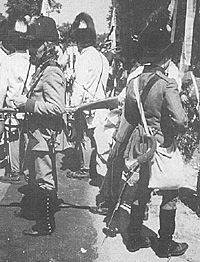 It was interesting to see Keith Raynor's article Hamilton
Smith's Experiment (AoN14 pp.12-13) about light infantry
colours. Thanks for acknowledging the real origins of rifle-armed
light troopsL It is clear however that some confusion exists about
the colour 'pike grey' used by such Austrian troops as the
Tyroleans mentioned at the top of the second column on p. 12.
It was interesting to see Keith Raynor's article Hamilton
Smith's Experiment (AoN14 pp.12-13) about light infantry
colours. Thanks for acknowledging the real origins of rifle-armed
light troopsL It is clear however that some confusion exists about
the colour 'pike grey' used by such Austrian troops as the
Tyroleans mentioned at the top of the second column on p. 12.
The problem seems to start with the name itself. In a military context, it would appear obvious that 'pike' was a reference to the weapon, but in German 'hecht' means fish, the nearest weaponry being 'Pike' or perhaps 'Hacken' meaning 'hook'. Consequently, the colour is not the green- (or olive-) grey shown in many illustrations nor a dull metal, but a medium blue-grey.
The main source of confusion has been the way these troops are depicted in Ottenfeld & Teuber's Die Oesterreichische Armee, which are copied in the Osprey MAX Over time, many military colours retain a description, but the shade changes, which is best exemplified in 'sky blue' which darkened markedly over the 19th Century. Painting in 1879, Ottenfeld was more familiar with the olive-green then worn by the Austrian light troops. His pictures of both Napoleonic and later Jaeger usually show them in bright sunshine, further lightening the apparent colour.
The 'hechtgrau' uniform was worn in the early part of the Napoleonic period by the Tyrolean Sharpshooters and Rifle Troops, a militia provided by the Tyrol as it was exempt from conscription. The 1794 Schernatis (annual almanac of the Army) shows these troops in a mid-blue very similar to the technical troops, whose uniform in the early part of the period was described as blue-grey. The colour continued beyond the Wars and a Jaeger bugler from 1820 shown on p. 242 in Almayer-Beck's Das Heer unter dem Doppeladler (198 1) has a fairly dark blue uniform. However, these colours were not fast and as an 18th century quote in Duffy's The Army of Maria Theresa (rep. 1990) on p. 70 mentions, 'hechtgrau could turn into a dirty ashen grey, (a light grey) when it got wet.
It demonstrates the importance of all aspects of this hobby working together, when the best advice to figure painters amongst you is to find a member of 1es Jaeger, (an Anglo-Austrian re-enactment unit) at an event to copy the exact shade'. Romain Baulesch, (commander of 1es Jaeger and based in Vienna), mentioned that there is no Humbrol 'authentic' colour, so you have to mix Matt 64 Grey and matt 25 Blue "in the right proportions".
The photograph from the July '94 Wagram event by Bryan Parkes shows he difference: the Ottenfeld colour is worn by the figure on the left (Znaimer Sharpshooter from the Czech Republic), while the figure on the right (les Jaeger) has the right colour although the photo has brought it up a little lilac. Not easy, is it?
Back to Napoleonic Notes and Queries # 16 Table of Contents
Back to Age of Napoleon List of Issues
Back to MagWeb Master List of Magazines
© Copyright 1995 by Partizan Press.
This article appears in MagWeb (Magazine Web) on the Internet World Wide Web.
Other articles from military history and related magazines are available at http://www.magweb.com